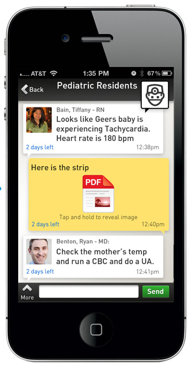TigerText Opens Its API TigerConnect
 Is it acceptable for physicians to text patient orders to the hospital? No, answered the Joint Commission in a 2011 statement. But that doesn’t mean that physicians don’t do it, despite the commission’s concerns that texting makes it difficult to verify the sender’s identification and that texts aren’t archived for validation purposes. Physicians still text because it is time-efficient, convenient, and they’re used to doing it in their everyday lives.
Is it acceptable for physicians to text patient orders to the hospital? No, answered the Joint Commission in a 2011 statement. But that doesn’t mean that physicians don’t do it, despite the commission’s concerns that texting makes it difficult to verify the sender’s identification and that texts aren’t archived for validation purposes. Physicians still text because it is time-efficient, convenient, and they’re used to doing it in their everyday lives.
For an idea of the kinds of scenarios in which texting makes sense, watch TigerText’s demo video. At one point a nurse asks the doctor to come down to the ER to look at a patient’s wound for signs of infection. Instead, the doctor asks for a picture message of the wound, and from the image he’s able to see that there’s no infection. As doctors’ workflows evolve with the times, TigerText aims to provide doctors with a secure way to carry out this type of communication.
“My brother who is 50 likes to say that basically nothing has changed on day-to-day health care communication since he was a resident,” CEO of TigerText Brad Brooks said of his brother, Andrew Brooks, MD, who is an advisor to the company. However, today the TigerText Pro solution is used by 350 enterprises, and the company’s announcement this week that it opened its API to third party developers means that its service could start to change more rapidly.
TigerText’s now open platform could allow physicians to start using text messaging to communicate with organizations outside of the hospital. For example, imaging labs and diagnostic companies will be able to send lab results from their facilities to physicians via TigerConnect, which Brooks describes as a conduit. They can also see when their files were delivered to and viewed by the physician, saving the labs the time of having to track doctors down by phone.
Brooks talked about a couple of other use cases made possible by the open API. TigerText has already integrated with AMiON, a physician schedule manager. The integration allows doctors to use their mobile device or computer to type in queries like “Dr. Green” or “4 p.m.” to find out when a specific doctor is on call or to find out who’s on at a particular time.
There’s also the possibility of introducing patient applications into the mix. TigerText will provide a Software Development Kit for companies that want to make use of TigerText’s already developed secure messaging. Brooks sees this as as way for them to move personal health information from a patient to a physician. “It takes a lot of time. We’ve got 25 engineers working on this full-time,” Brooks said. “Why not just rent our system effectively, and drop our SDK into your app so that you now have messaging?”
TigerText is currently moving one million messages a day across its system. It will be interesting to see how the open TigerConnect affects the volume of information traveling to physicians via text and if the system can help to nudge hospital communications into the twenty-first century.


 Idea for a guest post? Get in
Idea for a guest post? Get in